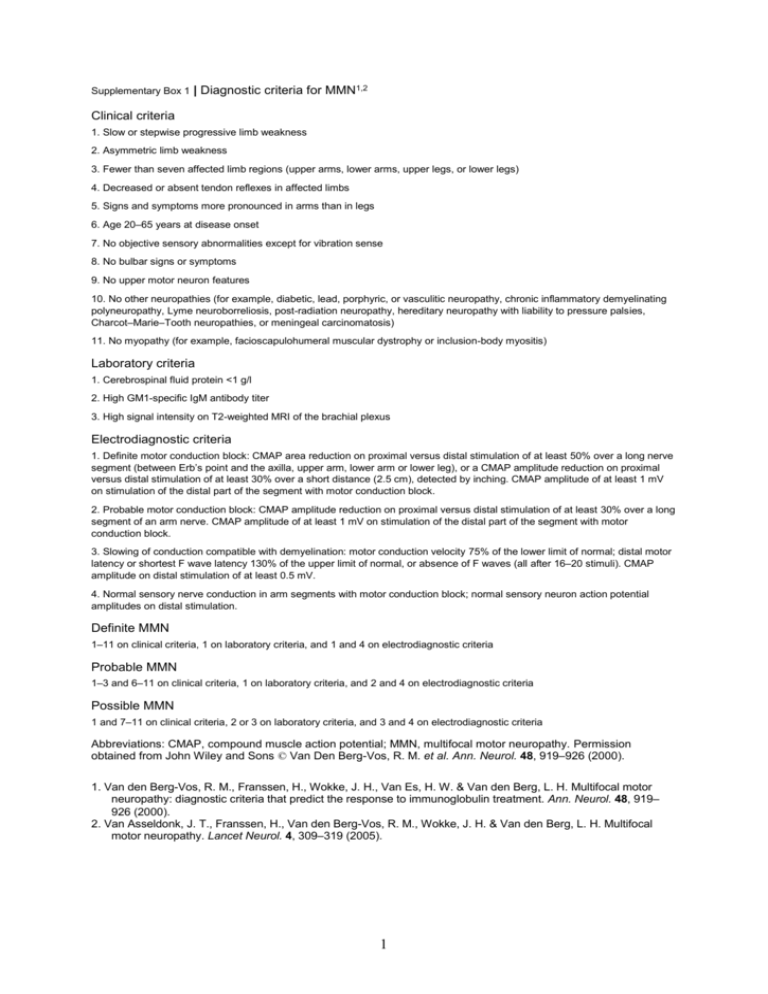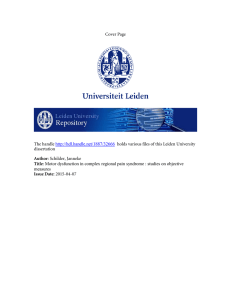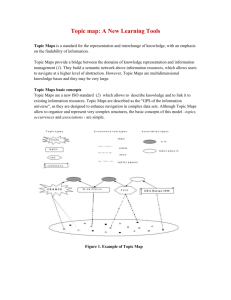Supplementary Box 1 - Word file (36 KB )
advertisement

Supplementary Box 1 | Diagnostic criteria for MMN1,2 Clinical criteria 1. Slow or stepwise progressive limb weakness 2. Asymmetric limb weakness 3. Fewer than seven affected limb regions (upper arms, lower arms, upper legs, or lower legs) 4. Decreased or absent tendon reflexes in affected limbs 5. Signs and symptoms more pronounced in arms than in legs 6. Age 20–65 years at disease onset 7. No objective sensory abnormalities except for vibration sense 8. No bulbar signs or symptoms 9. No upper motor neuron features 10. No other neuropathies (for example, diabetic, lead, porphyric, or vasculitic neuropathy, chronic inflammatory demyelinating polyneuropathy, Lyme neuroborreliosis, post-radiation neuropathy, hereditary neuropathy with liability to pressure palsies, Charcot–Marie–Tooth neuropathies, or meningeal carcinomatosis) 11. No myopathy (for example, facioscapulohumeral muscular dystrophy or inclusion-body myositis) Laboratory criteria 1. Cerebrospinal fluid protein <1 g/l 2. High GM1-specific IgM antibody titer 3. High signal intensity on T2-weighted MRI of the brachial plexus Electrodiagnostic criteria 1. Definite motor conduction block: CMAP area reduction on proximal versus distal stimulation of at least 50% over a long nerve segment (between Erb’s point and the axilla, upper arm, lower arm or lower leg), or a CMAP amplitude reduction on proximal versus distal stimulation of at least 30% over a short distance (2.5 cm), detected by inching. CMAP amplitude of at least 1 mV on stimulation of the distal part of the segment with motor conduction block. 2. Probable motor conduction block: CMAP amplitude reduction on proximal versus distal stimulation of at least 30% over a long segment of an arm nerve. CMAP amplitude of at least 1 mV on stimulation of the distal part of the segment with motor conduction block. 3. Slowing of conduction compatible with demyelination: motor conduction velocity 75% of the lower limit of normal; distal motor latency or shortest F wave latency 130% of the upper limit of normal, or absence of F waves (all after 16–20 stimuli). CMAP amplitude on distal stimulation of at least 0.5 mV. 4. Normal sensory nerve conduction in arm segments with motor conduction block; normal sensory neuron action potential amplitudes on distal stimulation. Definite MMN 1–11 on clinical criteria, 1 on laboratory criteria, and 1 and 4 on electrodiagnostic criteria Probable MMN 1–3 and 6–11 on clinical criteria, 1 on laboratory criteria, and 2 and 4 on electrodiagnostic criteria Possible MMN 1 and 7–11 on clinical criteria, 2 or 3 on laboratory criteria, and 3 and 4 on electrodiagnostic criteria Abbreviations: CMAP, compound muscle action potential; MMN, multifocal motor neuropathy. Permission obtained from John Wiley and Sons © Van Den Berg-Vos, R. M. et al. Ann. Neurol. 48, 919–926 (2000). 1. Van den Berg-Vos, R. M., Franssen, H., Wokke, J. H., Van Es, H. W. & Van den Berg, L. H. Multifocal motor neuropathy: diagnostic criteria that predict the response to immunoglobulin treatment. Ann. Neurol. 48, 919– 926 (2000). 2. Van Asseldonk, J. T., Franssen, H., Van den Berg-Vos, R. M., Wokke, J. H. & Van den Berg, L. H. Multifocal motor neuropathy. Lancet Neurol. 4, 309–319 (2005). 1







